Comprehensive Metabolomics Analysis of Xueshuan Xinmaining Tablet in Blood Stasis Model Rats Using UPLC-Q/TOF-MS
Abstract
:1. Introduction
2. Results
2.1. Effects of XXT on Hemorheological Parameters in Rats with BSS
2.2. Validation of UPLC-Q/TOF-MS
2.3. Metabolic Profiling of UPLC-Q/TOF-MS
2.4. Identification of BSS-Related Metabolites and Involved Pathway
2.5. Biochemical Interpretation
3. Discussion
4. Materials and Methods
4.1. Materials
4.2. BSS Model Construction and Drug Administration
4.3. Sample Collection and Processing
4.4. Model Assessment
4.5. Sample Preparation
4.6. UPLC-Q/TOF-MS Conditions
4.7. Data Analysis
5. Conclusions
Supplementary Materials
Author Contributions
Funding
Conflicts of Interest
References
- Tian, Y.; Yang, Z.F.; Li, Y.; Qiao, Y.; Yang, J.; Jia, Y.Y.; Wen, A.D. Pharmacokinetic comparisons of hydroxysafflower yellow A in normal and blood stasis syndrome rats. J. Ethnopharmacol. 2010, 129, 1–4. [Google Scholar] [CrossRef] [PubMed]
- Zheng, G.H.; Xiong, S.Q.; Chen, H.Y.; Mei, L.J.; Wang, T. Association of platelet-activating factor receptor gene rs5938 (G/T) and rs313152 (T/C) polymorphisms with coronary heart disease and blood stasis syndrome in a Chinese Han population. Chin. J. Integr. Med. 2017, 23, 893–900. [Google Scholar] [CrossRef] [PubMed]
- Xu, H.; Chen, K.J. Practical diagnostic criterion of blood stasis syndrome. Chin. J. Integr. Med. 2017, 23, 243–244. [Google Scholar] [CrossRef] [PubMed]
- Wang, J.; Xiong, X.J.; Feng, B. Aspirin resistance and promoting blood circulation and removing blood stasis: Current situation and prospectives. Evid. Based Complement. Altern. Med. 2014. [Google Scholar] [CrossRef] [PubMed]
- Liao, F.L.; Cao, J. Biomechanopharmacology in evaluation of herbs of activating blood circulation to remove blood stasis. Chin. J. Biomed. Eng. 2005, 14, 47–54. [Google Scholar]
- Lu, Y.; Hu, Y.L.; Kong, X.F.; Wang, D.Y. Selection of component drug in activating blood flow and removing blood stasis of Chinese herbal medicinal formula for dairy cow mastitis by hemorheological method. J. Ethnopharmacol. 2008, 116, 313–317. [Google Scholar] [CrossRef] [PubMed]
- Zou, Z.J.; Liu, Z.H.; Gong, M.J.; Han, B.; Wang, S.M.; Liang, S.W. Intervention effects of puerarin on blood stasis in rats revealed by a 1H-NMR-based metabonomic approach. Phytomedicine 2015, 22, 333–343. [Google Scholar] [CrossRef] [PubMed]
- Zhang, X.; Zhang, C.; Sai, J.; Li, F.; Liu, J.; Li, Y.; Wang, F. Xueshuan Xinmaining tablet treats blood stasis through regulating the expression of F13a1, Car1, and Tbxa2r. Evid. Based Complement. Altern. Med. 2015. [Google Scholar] [CrossRef] [PubMed]
- Xiong, L.X.; Xie, J.S.; Song, C.X.; Liu, J.P.; Zheng, J.T.; Liu, C.G.; Zhang, X.T.; Li, P.Y.; Wang, F. The activation of Nrf2 and its downstream regulated genes mediates the antioxidative activities of Xueshuan Xinmaining tablet in human umbilical vein endothelial cells. Evid. Based Complement. Altern. Med. 2015. [Google Scholar] [CrossRef] [PubMed]
- Liu, Y.T.; Peng, J.B.; Jia, H.M.; Cai, D.Y.; Zhang, H.W.; Yu, C.Y.; Zou, Z.M. UPLC-Q/TOF MS standardized Chinese formula Xin-Ke-Shu for the treatment of atherosclerosis in a rabbit model. Phytomedicine 2014, 21, 1364–1372. [Google Scholar] [CrossRef] [PubMed]
- Qi, Y.; Pi, Z.; Liu, S.; Song, F.; Lin, N.; Liu, Z. A metabonomic study of adjuvant-induced arthritis in rats using ultra-performance liquid chromatography coupled with quadrupole time-of-flight mass spectrometry. Mol. Biosyst. 2014, 10, 2617–2625. [Google Scholar] [CrossRef] [PubMed]
- Wang, X.; Sun, H.; Zhang, A.; Sun, W.; Wang, P.; Wang, Z. Potential role of metabolomics apporoaches in the area of traditional Chinese medicine: As pillars of the bridge between Chinese and Western medicine. J. Pharm. Biomed. Anal. 2011, 55, 859–868. [Google Scholar] [CrossRef] [PubMed]
- Ma, N.; Karam, I.; Liu, X.W.; Kong, X.J.; Qin, Z.; Li, S.H.; Jiao, Z.H.; Dong, P.C.; Yang, Y.J.; Li, J.Y. UPLC-Q-TOF/MS-based urine and plasma metabonomics study on the ameliorative effects of aspirin eugenol ester in hyperlipidemia rats. Toxicol. Appl. Pharmacol. 2017, 332, 40–51. [Google Scholar] [CrossRef] [PubMed]
- Wen, Z.; Yao, W.; Xie, L.; Yan, Z.Y.; Chen, K.; Ka, W.; Sun, D. Influence of neuraminidase on the characteristics of microrheology of red blood cells. Clin. Hemorheol. Microcirc. 2000, 23, 51–57. [Google Scholar] [PubMed]
- Li, S.; Lin, H.; Tang, Y.; Li, W.; Shen, J.; Kai, J.; Yue, S.; Shang, G.; Zhu, Z.; Shang, E.; et al. Comparative metabolomics analysis on invigorating blood circulation for herb pair Gui-Hong by ultra-high-performance liquid chromatography coupled to quadrupole time-of-flight mass spectrometry and pattern recognition approach. J. Pharm. Biomed. Anal. 2015, 107, 456–463. [Google Scholar] [CrossRef] [PubMed]
- Akiba, S.; Ohno, S.; Chiba, M.; Kume, K.; Hayama, M.; Sato, T. Protein kinase Calpha-dependent increase in Ca2+-independent phospholipase A2 in membranes and arachidonic acid liberation in zymosan-stimulated macrophage-like P388D1 cells. Biochem. Pharmacol. 2002, 63, 1969–1977. [Google Scholar] [CrossRef]
- Amano, H.; Ito, Y.; Eshima, K.; Kato, S.; Ogawa, F.; Hosono, K.; Oba, K.; Tamaki, H.; Sakagami, H.; Shibuya, M.; et al. ThromboxaneA2 induces blood flow recovery via platelet adhesion to ischemic regions. Cardiovasc. Res. 2015, 107, 509–521. [Google Scholar] [CrossRef] [PubMed]
- Rovati, G.E.; Capra, V. Cysteinyl-leukotriene receptors and cellular signals. Sci. World J. 2015, 7, 1375–1392. [Google Scholar] [CrossRef] [PubMed]
- Miller, W.L. Disorders in the initial steps of steroid hormone synthesis. J. Steroid Biochem. Mol. Biol. 2017, 165, 18–37. [Google Scholar] [CrossRef] [PubMed]
- Maloberti, P.; Castilla, R.; Castillo, F.; Cornejo Maciel, F.; Mendez, C.F.; Paz, C.; Podestá, E.J. Silencing the expression of mitochondrial acyl-CoA thioesterase I and acyl-CoA synthetase 4 inhibits hormone-induced steroidogenesis. FEBS J. 2005, 272, 1804–1814. [Google Scholar] [CrossRef] [PubMed]
- Stocco, D.M.; Wang, X.; Jo, Y.; Manna, P.R. Multiple signaling pathways regulating steroidogenesis and steroidogenic acute regulatory protein expression: More complicated than we thought. Mol. Endocrinol. 2005, 19, 2647–2659. [Google Scholar] [CrossRef] [PubMed]
- Lucki, N.C.; Sewer, M.B. The interplay between bioactive sphingolipids and steroid hormones. Steroids 2010, 75, 390–399. [Google Scholar] [CrossRef] [PubMed] [Green Version]
- Su, S.; Duan, J.; Cui, W.; Shang, E.; Liu, P.; Bai, G.; Guo, S.; Qian, D.; Tang, Y. Network-based biomarkers for cold coagulation blood stasis syndrome and the therapeutic effects of shaofu zhuyu decoction in rats. Evid. Based Complement. Altern. Med. 2013. [Google Scholar] [CrossRef] [PubMed]
- Wang, T.; Sun, H.G.; Hua, Y.L.; Li, P.L.; Wei, Y.M. Urine metabonomic study for blood-replenishing mechanism of Angelica sinensis in a blood-deficient mouse model. Chin. J. Nat. Med. 2016, 14, 210–219. [Google Scholar] [CrossRef]
- Li, H.X.; Han, S.Y.; Wang, X.W.; Ma, X.; Zhang, K.; Wang, L.; Ma, Z.Z.; Tu, P.F. Effect of the carthamins yellow from Carthamus tinctorius L. on hemorheological disorders of blood stasis in rats. Food Chem. Toxicol. 2009, 47, 1797–1802. [Google Scholar] [CrossRef] [PubMed]
- Lin, H.; Pi, Z.; Men, L.; Chen, W.; Liu, Z. Urinary metabonomic study of Panax ginseng in deficiency of vital energy rat using ultra performance liquid chromatography coupled with quadrupole time-of-flight mass spectrometry. J. Ethnopharmacol. 2016, 184, 10–17. [Google Scholar] [CrossRef] [PubMed]
- Zhao, Y.Y.; Cheng, X.L.; Wei, F.; Xiao, X.Y.; Sun, W.J.; Zhang, Y.; Lin, R.C. Serum metabolomics study of adenine-induced chronic renal failure in rats by ultra performance liquid chromatography coupled with quadrupole time-of-flight mass spectrometry. Biomarkers 2012, 17, 48–55. [Google Scholar] [CrossRef] [PubMed]
Sample Availability: Samples of the compounds are available from the authors. |
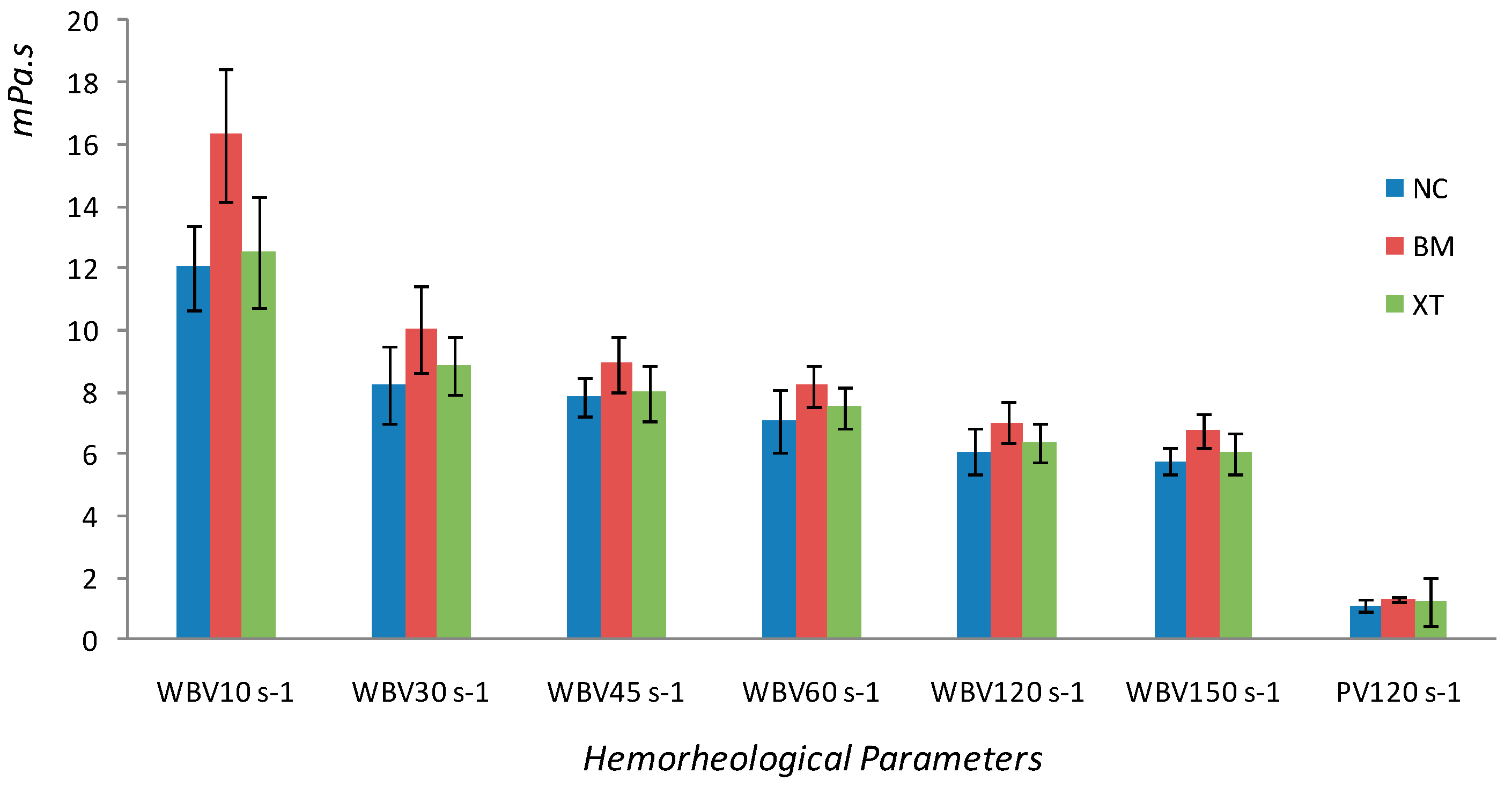
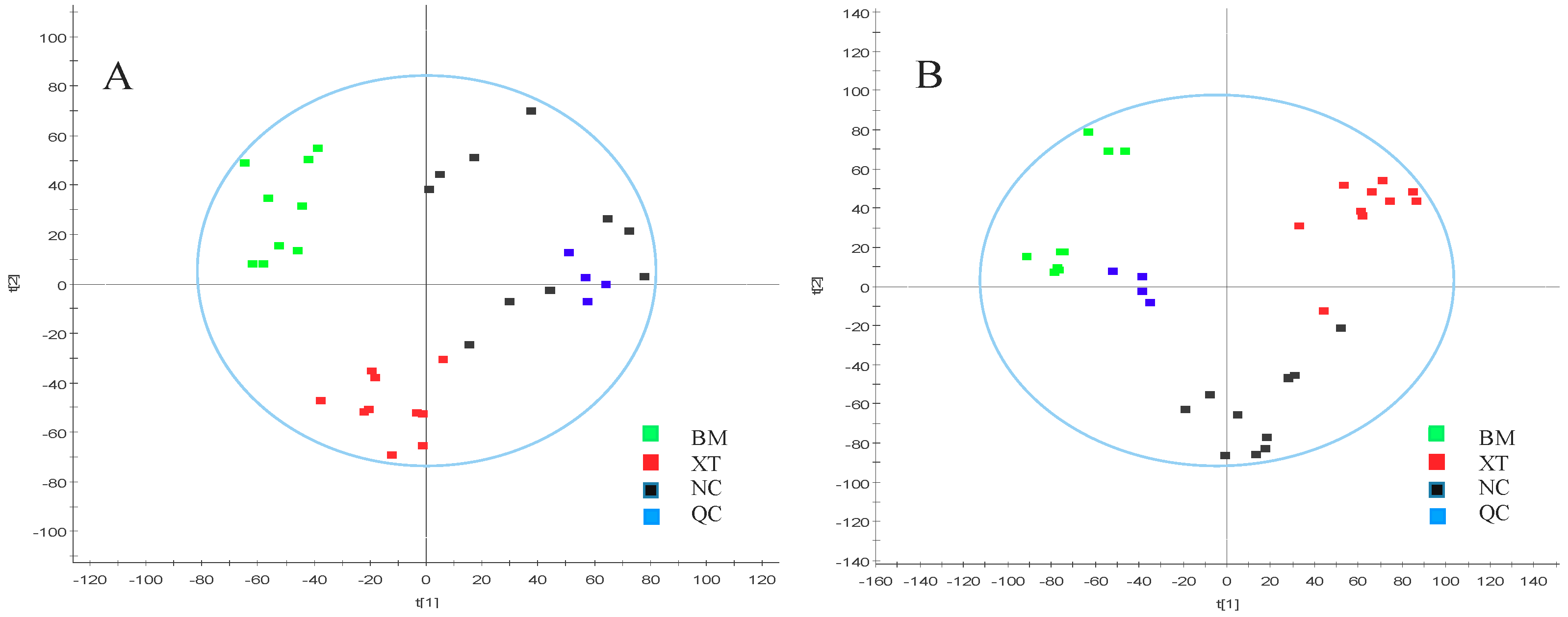
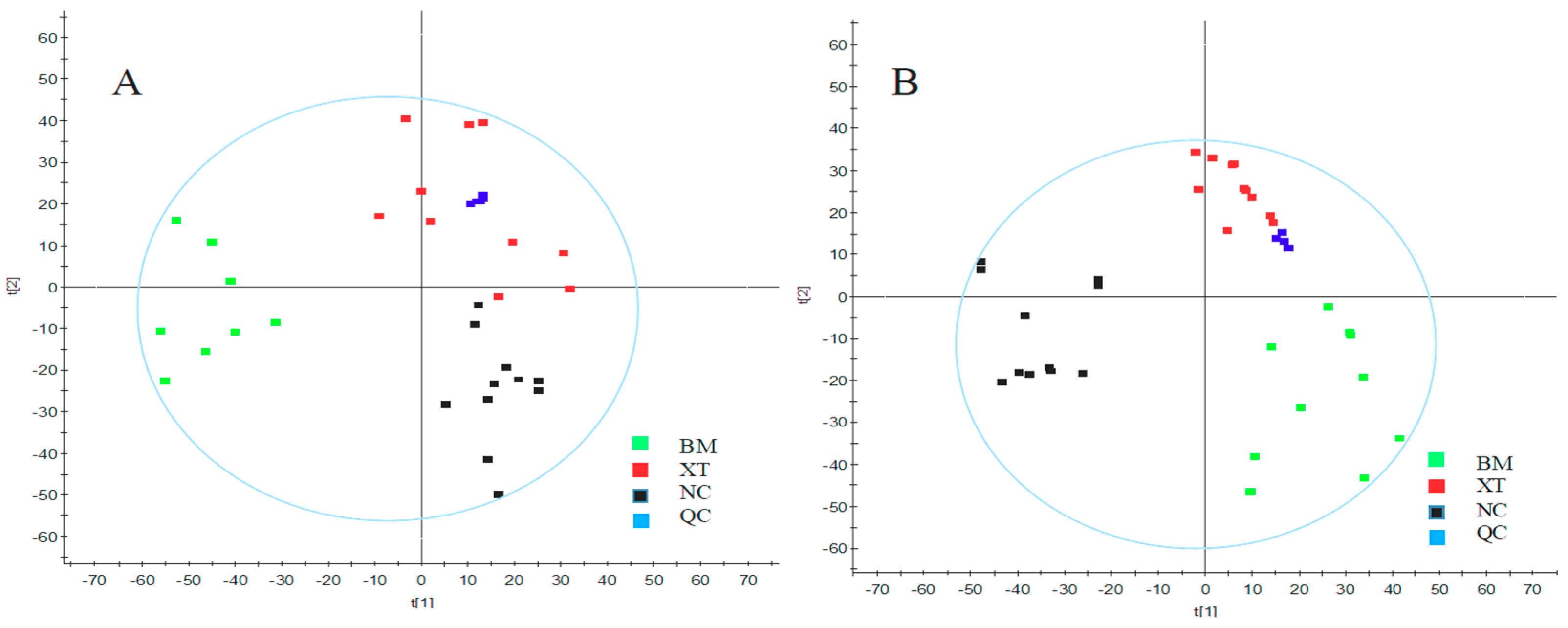
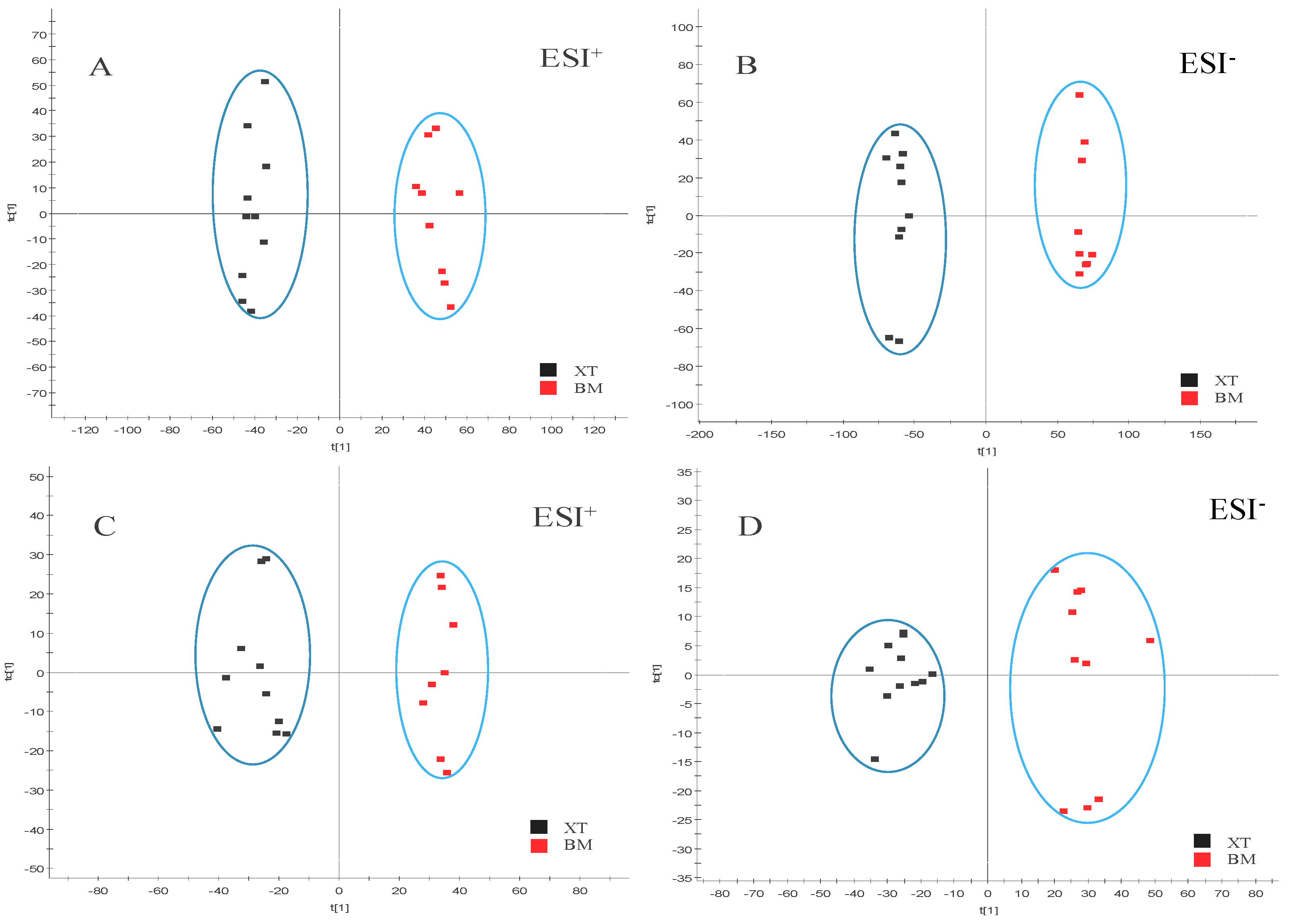
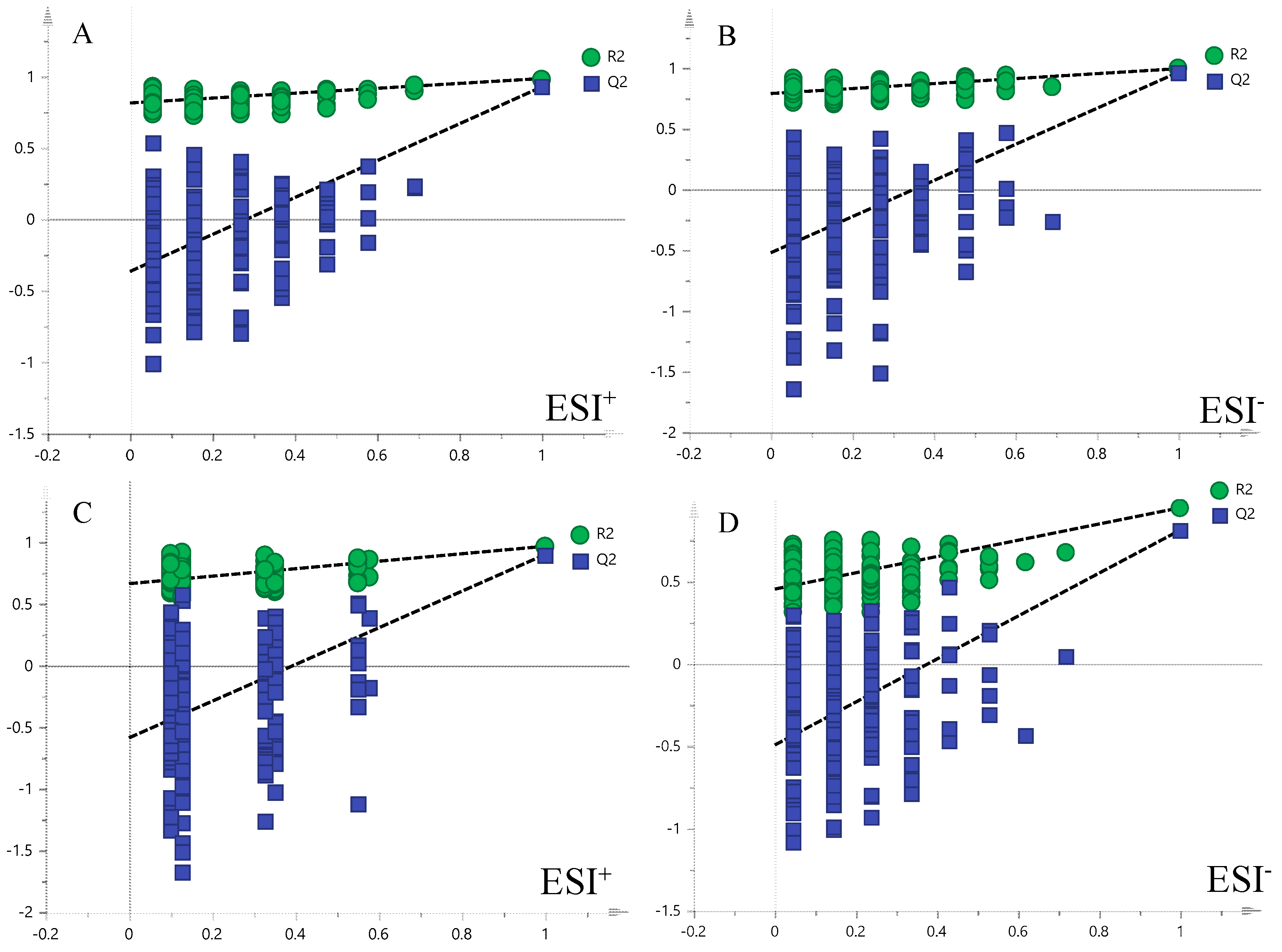
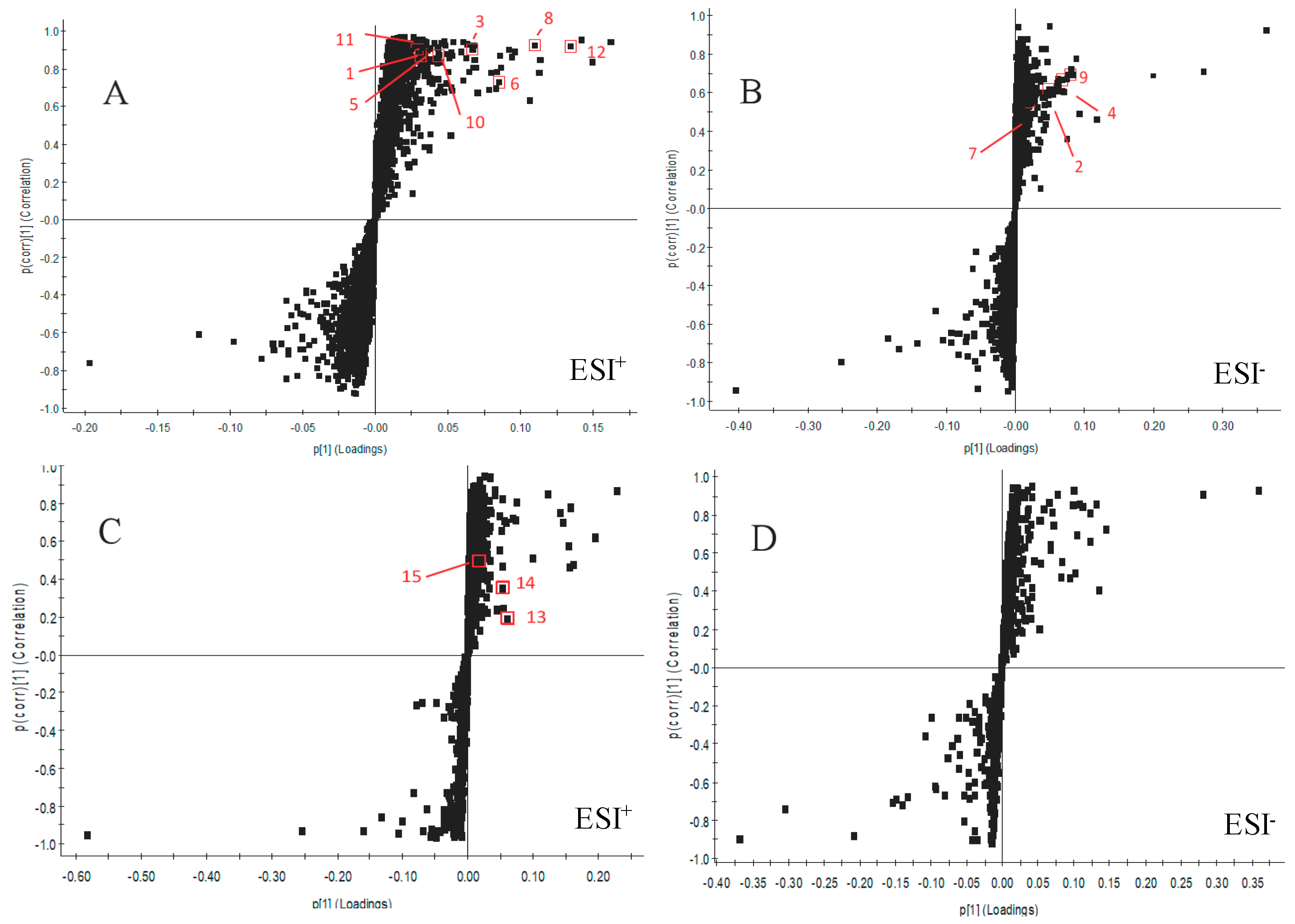
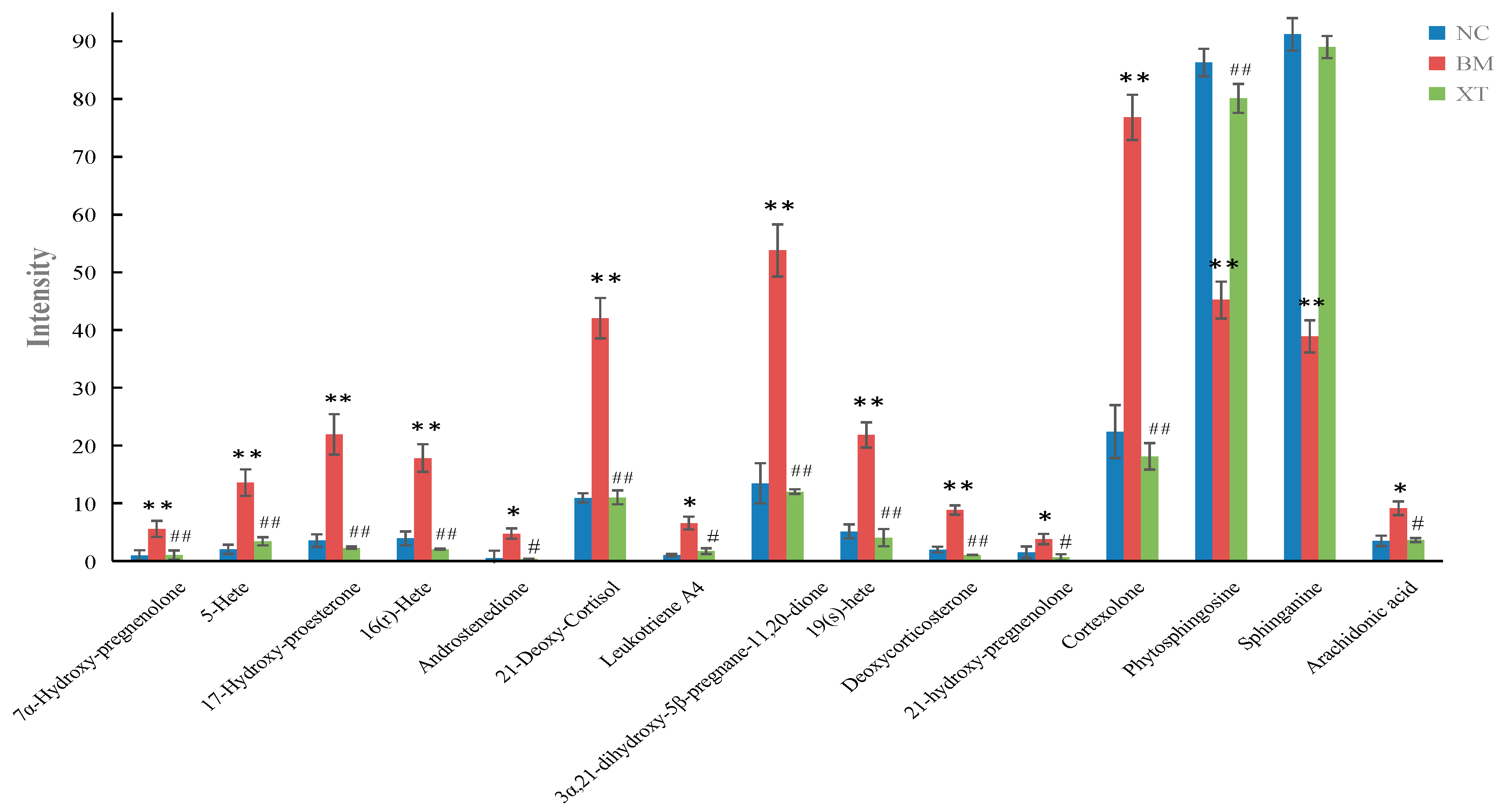
 : over-expressed in XT compared with BM;
: over-expressed in XT compared with BM;  : down expressed in XT compared with BM;
: down expressed in XT compared with BM;  : inhibiting the expression of Cholesterol/StAR).
: inhibiting the expression of Cholesterol/StAR).
 : over-expressed in XT compared with BM;
: over-expressed in XT compared with BM;  : down expressed in XT compared with BM;
: down expressed in XT compared with BM;  : inhibiting the expression of Cholesterol/StAR).
: inhibiting the expression of Cholesterol/StAR).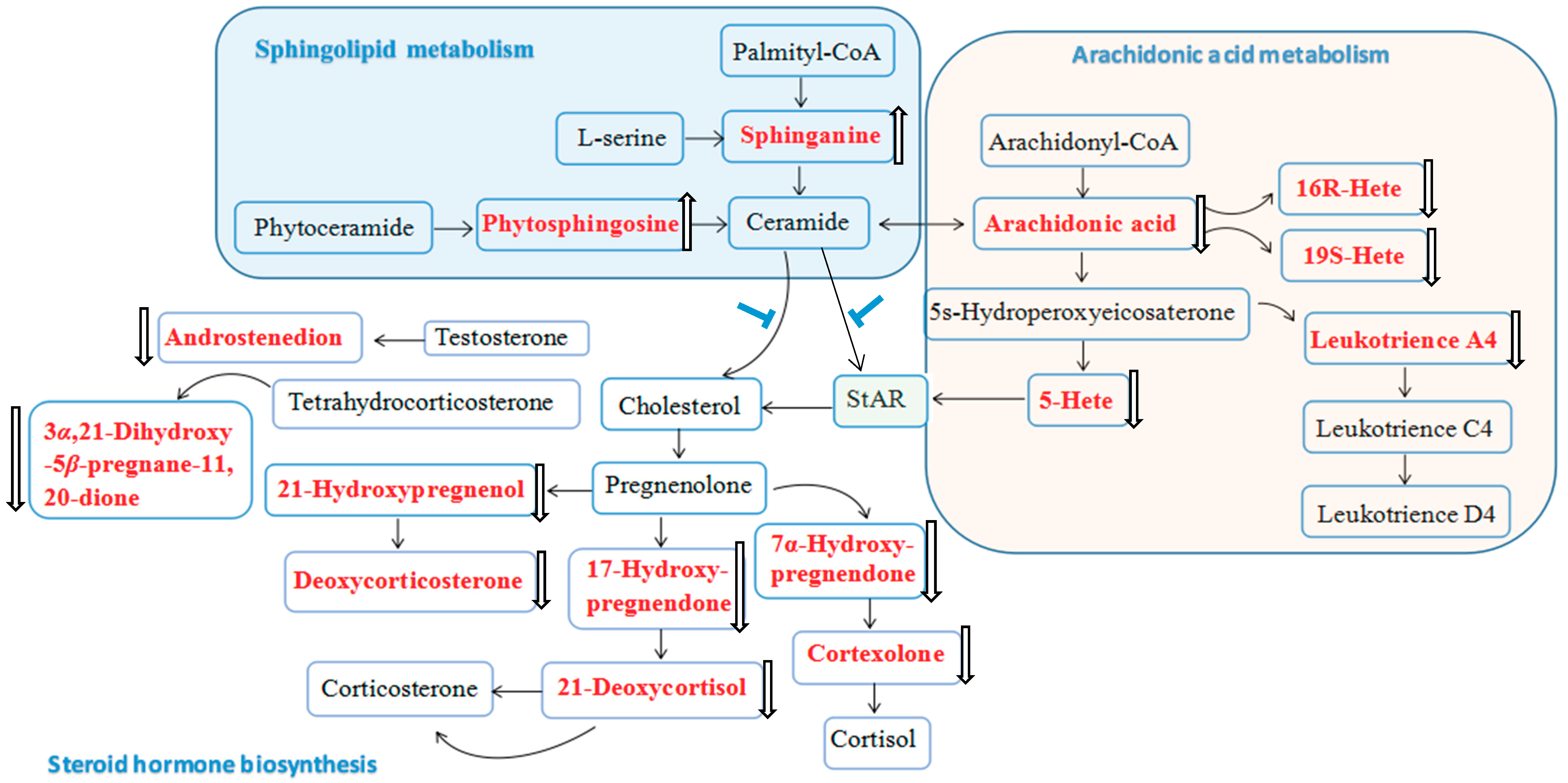
| Group | Whole Blood Viscosity (mPa·s) | Plasma Viscosity (mPa·s) 120 s−1 | |||||
|---|---|---|---|---|---|---|---|
| 10 s−1 | 30 s−1 | 45 s−1 | 60 s−1 | 120 s−1 | 150 s−1 | ||
| NC | 12.02 ± 1.39 ** | 8.26 ± 1.23 ** | 7.85 ± 0.65 ** | 7.05 ± 1.00 ** | 6.07 ± 0.74 ** | 5.78 ± 0.44 ** | 1.10 ± 0.18 ** |
| BM | 16.30 ± 2.12 | 10.04 ± 1.41 | 8.91 ± 0.87 | 8.21 ± 0.65 | 7.01 ± 0.66 | 6.74 ± 0.54 | 1.33 ± 0.08 |
| XT | 12.50 ± 1.79 * | 8.84 ± 0.93 * | 8.00 ± 0.89 * | 7.51 ± 0.64 * | 6.37 ± 0.63 * | 6.04 ± 0.67 * | 1.24 ± 0.80 * |
| Group | Hematocrit (%) | EAI |
|---|---|---|
| NC | 0.35 ± 0.05 ** | 2.09 ± 0.25 * |
| BM | 0.45 ± 0.10 | 2.41 ± 0.12 |
| XT | 0.37 ± 0.07 * | 2.09 ± 0.35 * |
| No. | RT (min) | Measured Mass (Da) | VIP | Formula | Error (ppm) | Identification | HMDB ID | Pathway | Content Level | Mode |
|---|---|---|---|---|---|---|---|---|---|---|
| 1 | 7.60 | 333.2421 | 2.83 | C21H32O3 | 0.6 | 7α-Hydroxypregnenolone | HMDB60424 | Steroid hormone biosynthesis | BM > XT ≈ NC | urine-ESI+ |
| 2 * | 8.17 | 365.2344 | 3.18 | C20H32O3 | 5.5 | 5-HETE | HMDB11134 | Arachidonic acid metabolism | BM > XT ≈ NC | urine-ESI− |
| 3 | 8.91 | 331.2271 | 5.98 | C21H30O3 | 3.0 | 17-Hydroxyprogesterone | HMDB00374 | Steroid hormone biosynthesis | BM > XT ≈ NC | urine-ESI+ |
| 4 * | 8.91 | 365.2340 | 4.39 | C20H32O3 | 1.4 | 16(R)-HETE | HMDB04680 | Arachidonic acid metabolism | BM > XT ≈ NC | urine-ESI− |
| 5 | 9.59 | 287.2018 | 2.87 | C19H26O2 | 2.8 | Androstenedione | HMDB00053 | Steroid hormone biosynthesis | BM > XT ≈ NC | urine-ESI+ |
| 6 * | 9.81 | 347.2221 | 8.13 | C21H30O4 | 1.7 | 21-Deoxycortisol | HMDB04030 | Steroid hormone biosynthesis | BM > XT ≈ NC | urine-ESI+ |
| 7 | 9.82 | 363.2180 | 1.33 | C20H30O3 | 3.0 | Leukotriene A4 | HMDB01337 | Arachidonic acid metabolism | BM > XT ≈ NC | urine-ESI− |
| 8 * | 9.91 | 349.2375 | 10.27 | C21H32O4 | 1.1 | 3α,21-Dihydroxy-5β-pregnane-11,20-dione | HMDB06755 | Steroid hormone biosynthesis | BM > XT ≈ NC | urine-ESI+ |
| 9 * | 9.94 | 365.2336 | 5.12 | C20H32O3 | 8.8 | 19(S)-HETE | HMDB11136 | Arachidonic acid metabolism | BM > XT ≈ NC | urine-ESI− |
| 10 * | 11.41 | 331.2269 | 3.87 | C21H30O3 | 6.9 | Deoxycorticosterone | HMDB00016 | Steroid hormone biosynthesis | BM > XT ≈ NC | urine-ESI+ |
| 11 | 12.64 | 333.2417 | 2.66 | C21H32O3 | 0.3 | 21-Hydroxypregnenolone | HMDB04026 | Steroid hormone biosynthesis | BM > XT ≈ NC | urine-ESI+ |
| 12 * | 12.82 | 347.2235 | 11.94 | C21H30O4 | 6.3 | Cortexolone | HMDB00015 | Steroid hormone biosynthesis | BM > XT ≈ NC | urine-ESI+ |
| 13 * | 13.19 | 318.3018 | 1.72 | C18H39NO3 | 4.4 | Phytosphingosine | HMDB04610 | Sphingolipid metabolism | BM < XT ≈ NC | urine-ESI+ |
| 14 * | 15.62 | 302.3068 | 2.58 | C18H39NO2 | 5.3 | Sphinganine | HMDB00269 | Sphingolipid metabolism | BM < XT ≈ NC | urine-ESI+ |
| 15 * | 22.68 | 305.2490 | 1.12 | C20H32O2 | 2.0 | Arachidonic acid | HMDB01043 | Arachidonic acid metabolism | BM > XT ≈NC | urine-ESI+ |
© 2018 by the authors. Licensee MDPI, Basel, Switzerland. This article is an open access article distributed under the terms and conditions of the Creative Commons Attribution (CC BY) license (http://creativecommons.org/licenses/by/4.0/).
Share and Cite
Tan, J.; Wang, C.; Zhu, H.; Zhou, B.; Xiong, L.; Wang, F.; Li, P.; Liu, J. Comprehensive Metabolomics Analysis of Xueshuan Xinmaining Tablet in Blood Stasis Model Rats Using UPLC-Q/TOF-MS. Molecules 2018, 23, 1650. https://doi.org/10.3390/molecules23071650
Tan J, Wang C, Zhu H, Zhou B, Xiong L, Wang F, Li P, Liu J. Comprehensive Metabolomics Analysis of Xueshuan Xinmaining Tablet in Blood Stasis Model Rats Using UPLC-Q/TOF-MS. Molecules. 2018; 23(7):1650. https://doi.org/10.3390/molecules23071650
Chicago/Turabian StyleTan, Jing, Cuizhu Wang, Hailin Zhu, Baisong Zhou, Lingxin Xiong, Fang Wang, Pingya Li, and Jinping Liu. 2018. "Comprehensive Metabolomics Analysis of Xueshuan Xinmaining Tablet in Blood Stasis Model Rats Using UPLC-Q/TOF-MS" Molecules 23, no. 7: 1650. https://doi.org/10.3390/molecules23071650
APA StyleTan, J., Wang, C., Zhu, H., Zhou, B., Xiong, L., Wang, F., Li, P., & Liu, J. (2018). Comprehensive Metabolomics Analysis of Xueshuan Xinmaining Tablet in Blood Stasis Model Rats Using UPLC-Q/TOF-MS. Molecules, 23(7), 1650. https://doi.org/10.3390/molecules23071650





